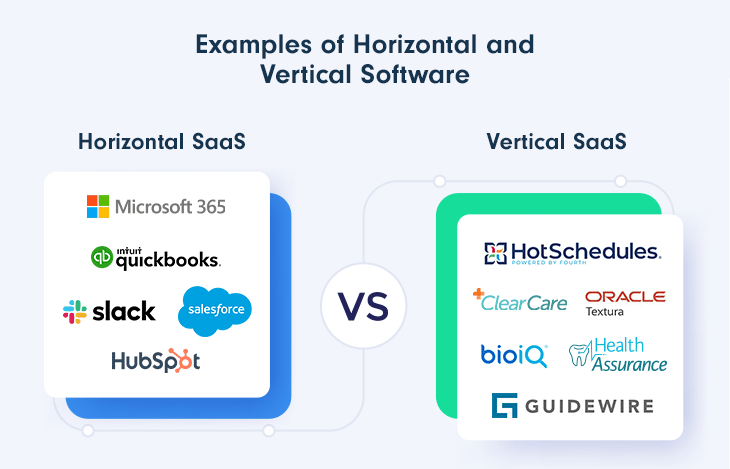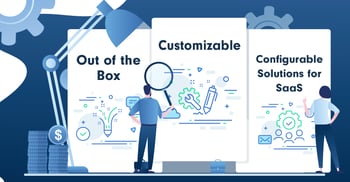Vertical vs Horizontal SaaS: Complete Guide for Business Growth

Vertical SaaS focuses on specific businesses with specialized solutions, whereas horizontal SaaS provides general-purpose tools to a wide range of users across numerous industries. Understanding this distinction is critical for selecting the best SaaS model for your business's growth strategy.
Data shows that organizations with over 1,000 employees utilize more than 150 SaaS applications. With SaaS use quickly increasing, the choice between vertical and horizontal techniques can decide your company's success.
What is Horizontal SaaS?
Horizontal SaaS offers cloud-based solutions that give general-purpose functionality to enterprises in all industries. These platforms address common business difficulties, regardless of industry vertical.
Popular Horizontal SaaS Examples
Some examples of horizontal SaaS are:
Cloud productivity solution: Microsoft Office 365
Messaging app: Slack
Accounting software: Quickbooks
Sales cloud: Salesforce
Customer relationship management platform Hubspot

How Can PayPro Global Help with Horizontal SaaS?
PayPro Global's eCommerce solution provides horizontal SaaS companies with multi-industry payment processing and global tax compliance. Our platform covers a wide range of customer requirements across several markets, allowing you to focus on scaling your horizontal SaaS product globally.
What is Vertical SaaS?
Vertical SaaS provides specialized software solutions tailored to specific sectors or niches. These platforms address specific challenges and needs within particular business verticals.
But vertical SaaS is newer and, therefore, less familiar to most people. However, its popularity increased, being regarded as a trend worth analyzing.
Some examples of vertical SaaS are:
Restaurant-management software: HotSchedules
Social care software ClearCare
Payment management platform: Textura by Oracle
Healthcare solution: BioIQ
Healthcare solution: Health Assurance Plan
Insurance software: Guidewire
How Can PayPro Global Help with Vertical SaaS?
PayPro Global provides industry-specific payment solutions and compliance management for vertical SaaS businesses. Our platform handles specialized billing requirements and regulatory compliance, enabling you to focus on delivering expert solutions to your niche market.
What are the Key Characteristics of each model?
|
Horizontal SaaS Key Characteristics |
Vertical SaaS Key Characteristics |
|
Niche market targeting - Serves specific industries only |
|
Specialized functionality - Addresses unique industry challenges |
|
Broad customer base - Serves diverse client demographics |
Expert knowledge required - Built with deep industry understanding |
|
Cross-industry applications - Works for retail, healthcare, finance, and more |
Custom solutions - Tailored to specific workflows and regulations |
eCommerce Partner
Thrive with the industry's most innovative all-in-one SaaS & Digital Goods solution. From high-performing payment and analytics tools to complete tax management, as well as subscription & billing handling, PayPro Global is ready to scale your SaaS.
Sell your SaaS globally with PayPro Global!
How Do Vertical and Horizontal SaaS Models Differ?
The seven key differences between vertical and horizontal SaaS models impact every aspect of your business strategy:
1. Market Size and Industry Scope
|
Horizontal SaaS |
Vertical SaaS |
|
- Targets multiple industries simultaneously
|
- Focuses on single industry vertical - Smaller but more focused market - Limited customer base but higher specialization |
2. Business Model Approach
|
Horizontal SaaS |
Vertical SaaS |
|
- End-to-end industry solutions |
3. Customer Acquisition Strategy
|
Horizontal SaaS |
Vertical SaaS |
|
- Lower competition |
4. Markketing & Sales Tactics
|
Horizontal SaaS |
Vertical SaaS |
|
- Relationship-focused approach |
5. Competition Landscape
|
Horizontal SaaS |
Vertical SaaS |
|
- Emerging market opportunities |
6. Growth Potential
|
Horizontal SaaS |
Vertical SaaS |
|
-Limited growth potential |
7. Management Complexity
|
Horizontal SaaS |
Vertical SaaS |
|
- Simplified product focus |
Vertical & Horizontal SaaS: Pros & Cons
What Are the Advantages of Vertical SaaS?
Vertical SaaS offers several compelling benefits for focused business strategies:
Business Advantages
- Lower competition levels - Fewer players in niche markets
- Faster market penetration - Easier to dominate specific verticals
- Higher customer retention - Limited alternatives increase stickiness
- Premium pricing potential - Specialized solutions command higher prices
Operational Benefits
- Targeted marketing - Lower customer acquisition costs
- Regulatory compliance - Easier industry-specific compliance
- Expert positioning - Viewed as industry specialists
- Upselling opportunities - Comprehensive solutions enable expansion
What Are the Disadvantages of Vertical SaaS?
Vertical SaaS also presents significant challenges:
Growth Limitations
- Market size constraints - Limited customer pool
- Scaling difficulties - Hard to expand beyond niche
- Brand recognition challenges - Harder to achieve widespread awareness
Business Risks
- Market dependency - Vulnerable to industry downturns
- Research requirements - Need deep industry knowledge
- Limited expansion options - Difficult to enter new verticals
What Are the Advantages of Horizontal SaaS?
Horizontal SaaS provides broad market opportunities:
Market Benefits
- Large customer base: the capacity to target several industries, scalability possibilities, and ease of business expansion.
- Brand recognition: faster market awareness.
- Revenue diversification: Additional industry sources
Growth Opportunities
- Expanded marketing reach: several media and audiences.
- Cross-selling possibilities - Multiple use cases per customer
- Market expansion - Simple geographical scaling
What Are the Disadvantages of Horizontal SaaS?
Horizontal SaaS faces intense competitive pressures:
Competitive Challenges
- High competition with several established players.
- Difficulties with differentiation: Difficult to stand out.
- Price Pressure - Commoditization Risks
Operational Complexities
- Increased customer success expenses - Supports multiple use cases
- Complex acquisition and longer sales cycles.
- Feature bloat risks: Attempting to serve everyone
Pro Tip
PayPro Global’s comprehensive MOR platform reduces operational complexity while supporting your growth across multiple markets and customer segments.
How Do You Choose Between Vertical and Horizontal SaaS?
Select your SaaS model by answering these critical questions:
1. What Problems Does Your Product Solve?
- Industry-specific challenges → Choose vertical SaaS
- Universal business problems → Choose horizontal SaaS
2. Who Is Your Target Audience?
- Specific industry professionals → Choose vertical SaaS
- General business users → Choose horizontal SaaS
3. What's Your Competitive Landscape?
- Niche market with few players → Choose vertical SaaS
- Large market with differentiation potential → Choose horizontal SaaS
4. What Are Your Growth Goals?
- Deep market penetration → Choose vertical SaaS
- Rapid scaling across markets → Choose horizontal SaaS
What Factors Should Guide Your SaaS Strategy Decision?
Consider these additional factors when choosing your approach:
Market Analysis Requirements
- Industry size assessment - Ensure sufficient market opportunity
- Competition evaluation - Analyze existing solutions
- Customer needs research - Validate problem-solution fit
Resource Considerations
- Team expertise - Do you have industry knowledge?
- Development capacity - Can you build specialized features?
- Marketing budget - What acquisition costs can you support?
Long-term Vision
- Expansion plans - How do you want to grow?
- Exit strategy - What are your ultimate goals?
- Risk tolerance - How much uncertainty can you handle?
The PayPro Global Approach
PayPro Global's scalable MOR platform grows with your SaaS business, whether you choose vertical or horizontal approaches.
Our solution provides the necessary infrastructure for global expansion, while also handling complex payment processing and compliance requirements.
How Can You Implement Your Chosen SaaS Model?
Once you've selected your approach, follow these implementation steps:
For Vertical SaaS Implementation
- Conduct deep industry research - Understand specific pain points
- Build industry expertise - Hire domain experts
- Develop specialized features - Create industry-specific functionality
- Target niche marketing channels - Focus on industry publications and events
For Horizontal SaaS Implementation
- Identify common pain points - Find problems across industries
- Build flexible solutions - Create adaptable functionality
- Develop broad marketing strategy - Target multiple audiences
- Focus on scalable architecture - Prepare for rapid growth
Did You Know?
PayPro Global offers ready-to-deploy MoR infrastructure saving months of development time for both vertical and horizontal SaaS businesses.
Our platform manages global payments, subscription billing, and tax compliance from the start, allowing you to launch quickly and focus on core product development.
eCommerce Partner
Thrive with the industry's most innovative all-in-one SaaS & Digital Goods solution. From high-performing payment and analytics tools to complete tax management, as well as subscription & billing handling, PayPro Global is ready to scale your SaaS.
Sell your SaaS globally with PayPro Global!
What's the Future of Vertical vs Horizontal SaaS?
The SaaS market continues evolving with distinct trends for each model:
Vertical SaaS Trends
- Increasing specialization - More niche solutions emerging
- AI integration - Industry-specific AI capabilities
- Regulatory compliance focus - Enhanced compliance features
Horizontal SaaS Trends
- Platform consolidation - All-in-one solutions gaining popularity
- API-first approaches - Integration-focused development
- Vertical expansion - Horizontal players adding industry features
Conclusion
The decision between vertical and horizontal SaaS is based on your market potential, competitive landscape, and growth goals. Vertical SaaS provides less rivalry and more specialization, but horizontal SaaS provides a larger market potential and scaling options.
Whether you choose to be a specialist or a generalist, your primary goal should be to solve real-world client problems and provide outstanding value.
Partner with professional eCommerce platforms like PayPro Global’s Merchant of Record, to handle operational challenges so you can focus on product development and customer success.
Frequently Asked Questions
FAQs
What's the main difference between vertical and horizontal SaaS?
Vertical SaaS serves one specific industry niche (e.g., software for restaurants), while Horizontal SaaS serves many industries with a general-purpose tool (e.g., accounting software). It's the difference between being a specialist or a generalist.
Which model has less competition and is easier to market?
Vertical SaaS generally has less competition and is easier to market. Its focused nature allows for highly targeted marketing to a niche audience, which often results in lower acquisition costs compared to the broad, competitive landscape of horizontal SaaS.
Which SaaS model has more growth potential?
Horizontal SaaS typically has more growth potential due to a much larger total addressable market. These businesses can scale across numerous industries and geographic regions, while vertical SaaS growth is limited to the size of its specific niche.
How do I choose the right SaaS model for my business?
Base your choice on the problem you solve. If your product fixes a challenge unique to one industry, choose vertical SaaS. If it solves a common problem that almost any business faces, choose horizontal SaaS.
How does a payment partner support these models?
A flexible payment partner, or Merchant of Record (MoR), helps both models by handling complex operations. It manages global tax and payment processing for broad horizontal platforms and handles specialized compliance for niche vertical companies.
Ioana Grigorescu
Ioana Grigorescu is PayPro Global's Content Manager, focused on creating strategic writing pieces for SaaS, B2B, and technology companies. With a background that combines Languages and Translation Studies with Political Sciences, she's skilled in analyzing, creating, and communicating impactful content. She excels at developing content strategies, producing diverse marketing materials, and ensuring content effectiveness. Beyond her work, she enjoys exploring design with Figma.
-
1.Explore PayPro Global's Solutions: See how our platform can help you streamline your payment processing and boost revenue.
-
2.Get a Free Consultation: Discuss your specific needs with our experts and discover how we can tailor a solution for you.
-
3.Download our Free Resources: Access valuable guides, checklists, and templates to optimize your online sales.
-
4.Become a Partner: Expand your business by offering PayPro Global's solutions to your clients.
- Vertical SaaS focuses on specific businesses with specialized solutions, whereas horizontal SaaS provides general-purpose tools for a variety of industries.
- Vertical SaaS benefits from lower competition and improved client retention, but it has market size restrictions.
- Horizontal SaaS has a wider client base and more scaling possibilities, but it faces severe competition and sophisticated operations.
Get the latest news



